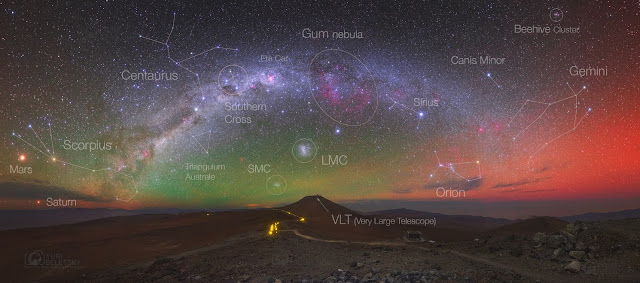Astronomia, astrofísica, astrogeologia, astrobiologia, astrogeografia. O macro Universo em geral, deixando de lado os assuntos mundanos. Um olhar para o sublime Universo que existe além da Terra e transcende nossas brevíssimas vidas. Astronomy astrophysics, astrogeology, astrobiology, astrogeography. The macro Universe in general, putting aside mundane subjects. A look at the sublime Universe that exists beyond Earth and transcends our rather brief life spans.
Pesquisar conteúdo deste blog
terça-feira, 7 de fevereiro de 2017
Milky Way with Airglow Australis | A Via Láctea com brilho atmosférico austral
Captada em abril passado após o pôr-do-sol em uma noite de inverno no Chile, um excepcionalmente intenso brilho atmosférico (airglow) tomou conta do cenário.
A panorâmica paisagem celeste é também cheia de estrelas, aglomerados e nebulosas ao longo da parte sul da Via Láctea, incluindo a Grande e a Pequena Nuvem de Magalhães.
Originando-se a uma altitude similar à das auroras, o luminoso brilho atmosférico é causado por quimioluminescência, a produção de luz através de excitação química. Comummente registrado com uma coloração esverdeada por câmeras digitais sensíveis, as emissões de brilho atmosférico tanto vermelhas quanto verdes que aparecem aqui são predominantemente causadas por átomos de oxigênio atmosférico a densidades extremamente baixas, e tem frequentemente estado presentes em noites no hemisfério sul durante os últimos meses.
Assim como a Via Láctea naquela noite escura, o intenso brilho atmosférico era visível a olho nu, porém sem cor. Marte, Saturno, e a brilhante estrela Antares em Escorpião formam o triângulo celestial que ancora a cena à esquerda. A estrada vai me direção à montanha Cerro Paranal, de 2.600 metros de altura e aos Ultra Grandes Telescópios do Observatório Austral Europeu.
Tradução de Luiz Leitão da Cunha
Captured last April after sunset on a Chilean winter's night an exceptionally intense airglow flooded this scene.
The panoramic skyscape is also filled with stars, clusters, and nebulae along the southern Milky Way including the Large and Small Magellanic clouds.
Originating at an altitude similar to aurorae, the luminous airglow is due to chemiluminescence, the production of light through chemical excitation. Commonly recorded with a greenish tinge by sensitive digital cameras, both red and green airglow emission here is predominately from atmospheric oxygen atoms at extremely low densities and has often been present in southern hemisphere nights during the last few years.
Like the Milky Way on that dark night the strong airglow was visible to the eye, but seen without color. Mars, Saturn, and bright star Antares in Scorpius form the celestial triangle anchoring the scene on the left. The road leads toward the 2,600 meter high mountain Cerro Paranal and the European Southern Observatory's Very Large Telescopes.
Assinar:
Postar comentários (Atom)

Nenhum comentário:
Postar um comentário